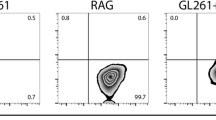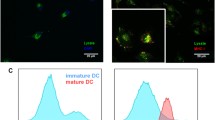Abstract.
Rats bearing a 5-day intracranial (i.c.) syngeneic glioma were treated with a subcutaneous (s.c.) vaccination consisting of irradiated glioma cells or a multimodality approach composed of radiotherapy plus s.c. vaccination. Vaccination of rats harboring a T9 glioma with 5×106 irradiated T9.F glioma cells (a clone derived from the T9 glioblastoma cell line) resulted in a marked enhancement of i.c. glioma growth and a significant decrease in survival. Histopathology of the tumors from vaccinated rats revealed a massive glioma composed of healthy tumor tissue lacking any marked inflammation, edema or hemorrhage. Analysis of the tumor-infiltrating mononuclear cells indicated that gliomas from vaccinated rats contained a 10-fold greater lymphoid infiltrate per milligram of tumor as compared to tumors from non-vaccinated rats, suggesting that the vaccination had induced immune cells to localize to the i.c. glioma. Combined treatment consisting of 15 Gy of whole head irradiation of the 5-day glioma followed by vaccination with T9.F cells resulted in a significant increase in survival compared to that of non-treated rats, 45% of which remained tumor-free. Microscopic evaluation in survivors of the tumor implantation site revealed the presence of hemosiderin-laden macrophages and other mononuclear cells, with the absence of tumor cells within the residual lesion. When survivors were challenged s.c. with viable T9.F glioma cells, a delayed-type hypersensitivity (DTH) reaction appeared at the challenge site. T cells purified from these rats proliferated and secreted Th1-associated cytokines when stimulated with irradiated T9.F glioma cells, and lysed T9.F target cells. In contrast, when these rats were challenged s.c. with the unrelated MadB106 adenocarcinoma, tumor formation was observed. These findings indicate that the treatment of an established i.c. glioma with a cellular vaccination alone may induce enhanced tumor growth; however, when the vaccination is combined with radiation therapy, the results are beneficial in terms of increased survival time or complete remission that is accompanied by the development of tumor-specific cellular immunity.
Similar content being viewed by others
Author information
Authors and Affiliations
Additional information
Electronic Publication
Rights and permissions
About this article
Cite this article
Graf, M.R., Prins, R.M., Hawkins, W.T. et al. Irradiated tumor cell vaccine for treatment of an established glioma. I. Successful treatment with combined radiotherapy and cellular vaccination. Cancer Immunol Immunother 51, 179–189 (2002). https://doi.org/10.1007/s00262-002-0269-3
Received:
Accepted:
Issue Date:
DOI: https://doi.org/10.1007/s00262-002-0269-3




